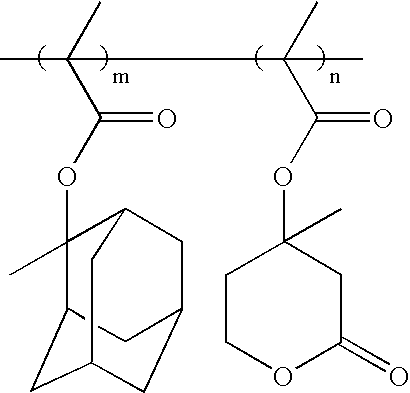Photosensitive polymer having cyclic backbone and resist composition containing the same
a polymer and backbone technology, applied in the field of chemically amplified resist compositions, can solve the problems of affecting the use of conventional resist materials, the resistance of polymers to dry etching is weak, and the use of present resist materials that are commercially used in lithography processes employing arf excimer lasers suffer certain drawbacks when compared with more conventional resist materials, etc., to achieve the effect of improving adhesion to the underlying layer, reducing manufacturing costs, and increasing resistance to dry
- Summary
- Abstract
- Description
- Claims
- Application Information
AI Technical Summary
Benefits of technology
Problems solved by technology
Method used
Image
Examples
example 1
Synthesis of 8-ethyl-8-tricyclodecanol
[0034]A solution of 200 ml (1.0 mol) of ethyl magnesium bromide dissolved in diethyl ether was put into a 500 ml three-necked round-bottom flask, 30 g (0.2 mol) of tricyclodecan-8-one dissolved in diethyl ether was slowly dropped thereinto at room temperature using a dropping funnel, and was then reacted in a reflux condition for about 12 hours.
[0035]After the reaction was completed, the reactant was poured into excess water and neutralized using HCl. Thereafter, a crude product was extracted using diethyl ether and dried using MgSO4. Then, the solvent was evaporated and a desired product was separated from the crude product using column chromatography (yield: 65%).
example 2
Synthesis of 8-ethyl-8-tricyclodecanyl acrylate
[0036]18 g (0.1 mol) of 8-ethyl-8-tricyclodecanol synthesized in Example 1 and 11 g (0.11 mol) of triethylamine were dissolved in 200 ml of anhydrous tetrahydrofuran (THF) and 10 g (0.11 mol) of acryloyl chloride was slowly added thereto at room temperature, and then the reactant was reacted for about 12 hours.
[0037]After the reaction was completed, excess solvent was evaporated, and the reactant was poured into excess water and neutralized using HCl. Thereafter, a crude product was extracted using diethyl ether and dried using MgSO4. Then, the solvent was evaporated and a desired product was separated from the crude product using column chromatography (yield: 75%).
example 3
Synthesis of 8-ethyl-8-tricyclodecanyl methacrylate
[0038]18 g (0.1 mol) of 8-ethyl-8-tricyclodecanol synthesized in Example 1 and 11 g (0.11 mol) of triethylamine were dissolved in 200 ml of anhydrous THF and 0.11 mol of methacryloyl chloride was reacted in the same manner as in Example 2. Then, a desired product was separated in the same manner as in Example 2 (yield: 75%).
PUM
| Property | Measurement | Unit |
|---|---|---|
| size | aaaaa | aaaaa |
| wavelength | aaaaa | aaaaa |
| wavelength | aaaaa | aaaaa |
Abstract
Description
Claims
Application Information
 Login to View More
Login to View More - R&D
- Intellectual Property
- Life Sciences
- Materials
- Tech Scout
- Unparalleled Data Quality
- Higher Quality Content
- 60% Fewer Hallucinations
Browse by: Latest US Patents, China's latest patents, Technical Efficacy Thesaurus, Application Domain, Technology Topic, Popular Technical Reports.
© 2025 PatSnap. All rights reserved.Legal|Privacy policy|Modern Slavery Act Transparency Statement|Sitemap|About US| Contact US: help@patsnap.com



